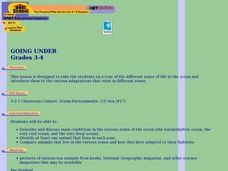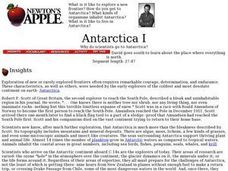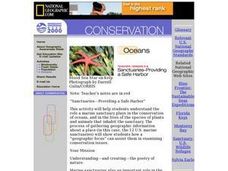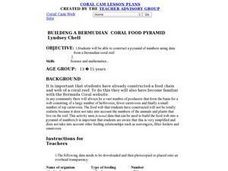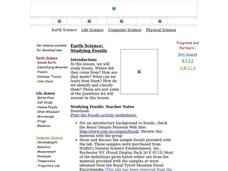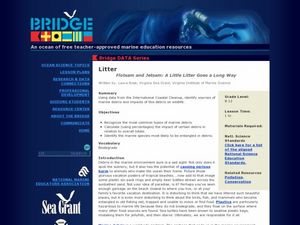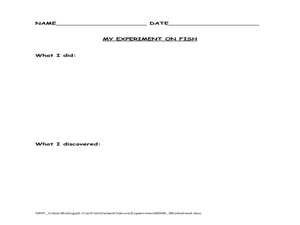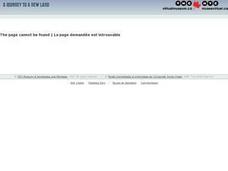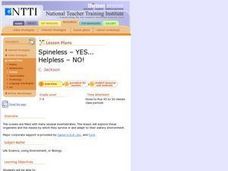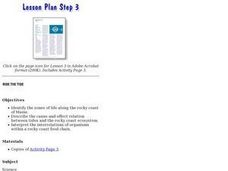Curated OER
Have to Have a Habitat
Students create a zoological and botanical garden made up of a variety of species from around the world.
Curated OER
Antarctica I
Students explore exploring and expiditions then simlate their own on campus. They divide into small "expedition groups." Have each team report back to the class about their expeditions, using written, oral, or videotaped presentations.
Curated OER
Sanctuaries-Providing a Safe Harbor
Students investigate the role of marine sanctuaries in the conservation of oceans and the lives of plant and animal species that live there. They write poetry to exhibit what they learn.
Curated OER
Corals and Coral Reefs
Students label the continents, oceans, and seas on a provided world map and use it to determine where they would expect most of the world's coral reefs to be found based on provided information the teacher has read to them.
Curated OER
Hush! A Thai Lullaby
Students listen as the teacher reads a story from their textbooks about a tradition in Thailand. They locate Thailand on a map and discuss that it is a tropical country. They discuss various cultural aspects included in the story and...
Curated OER
The Science Behind Dolphins
Students discover facts about marine mammals, specifically dolphins. In this K-2 lesson plan, students identify the different species of Cetaceans, focusing on dolphins. Students answer true/false questions regarding cetaceans and...
Curated OER
WONDERFUL, WATERFUL WETLANDS
Students list characteristics of wetland and describe the functions of a wetland.
Curated OER
Characteristics of Snakes and Turtles
Students compare and contrast snakes and turtles, then fill out an information sheet.
Curated OER
The Weight of Water
Students examine how salt water is more dense than fresh water. They discuss how manatees need to float and sink, conduct a sink or float experiment, and conduct an experiment with eggs and salt and fresh water.
Curated OER
Hermit Crabs Lifecycle & Stages
Young scholars review the life cycle of land hermit crabs by viewing a poster or transparency. They identify the different body parts of a hermit crab and what each part is used for.
Curated OER
Edward Burtynsky's Ship Breaking
Seventh graders view Edward Burtynsky's artwork that represents ship breaking. They view images of recycling, the water cycle, rusted metal, and ships to determine factors that threaten the existence of a particular habitat of an...
Curated OER
Science: Coral Reef Food Pyramid
Students construct numbers pyramids using fictional data from a coral reef. they tally the numbers of carnivores, herbivores, and producers. Students next build a pyramid shape in which they put their numbers of producers, herbivores,...
Curated OER
Studying Fossils
Students study fossils. They examine samples of specific fossils--including a shark tooth, a brachiopod, and horn coral, among others. They visit corresponding websites and complete a worksheet regarding each of the fossils.
Curated OER
LitterFlotsam and Jetsam: A Little Litter Goes a Long Way
Students explore the concept of environmental stewardship. In this science lesson, students investigate data from the International Coastal Cleanup, identify sources of marine debris, and discover the impacts of this debris on wildlife.
Curated OER
Comparing and Contrasting
Young scholars practice compare and contrast skills. In this science and language development lesson, students complete a T chart generating traits of a snail and a clam. Young scholars complete a related worksheet.
Curated OER
Let's Go to the Video Tape!
Students examine biological diversity and see how it relates to the concepts of variety and relative abundance. In this investigative lesson students view a video on biodiversity and complete an activity.
Curated OER
Urban Biology: Can Fish Detect Odors
Students investigate how fish use their sense of smell. In this scientific method activity, students design and perform an experiment to investigate how fish use their sense of smell. This activity includes statistical analysis and...
Curated OER
Ice Age Challenge Game
Students use a website to do various projects about the ice age and discover the route taken by the first arrivals are unknown and are the subject of a great deal of debate and research.
Curated OER
Spineless - YES... Helpless - NO!
Students distinguish between invertebrate and vertebrate organisms while examining the zoological classes of a number of invertebrates. They illustrate a food web of these organisms and investigate the impact of humans on the oceanic...
Curated OER
Ride the Tide
Students examine the cause-and-effect relationship between tides and the rocky coast ecosystem. They complete a worksheet that illustrates the intertidal zone.
Curated OER
Island Biogeography
Students work in small groups to sort through photos of an ecosystem following a major disturbance. They place these photos in chronological order to show the process of succession. They then do an experiment with yeast to show the...
Curated OER
Ocean Life
Students research and identify ocean animals characteristics and life styles using the Internet and books. They create a PowerPoint presentation and an iMovie to present to the class.
Curated OER
Food Web
Students are able to define food web, and identify the interdependence of organisms within a system. They are able to describe how natural events and human activities can impact a food web.
Other popular searches
- Animals Word Search
- Sea Prehistoric Animals
- African Animals Word Search
- Animals Word Search Puzzle
- Animals and the Seasons
- Seasonal Changes on Animals
- Arctic Animals Word Search
- Farm Animals Word Search
- Pond Animals Word Search
- Animals Changing Seasons
- Animals and Seasons
- Animals and Changing Seasons

